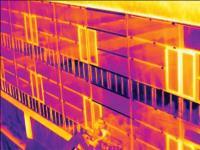Thermal Performance of Facades

This investigation seeks to quantify the effects of thermal bridging in commercial facades and then propose alternative solutions to improve performance. The purpose of this investigation is to study methods for improving typical details to bring the theoretical and actual performance into closer alignment. Based on thousands of images collected, the researchers identified 16 areas of thermal bridging that might commonly occur in commercial structures using industry standard details. Broken into two broad categories of façade systems and transitions/penetrations, they address systems such as curtain wall supports, rain screens, existing wall renovations and transitions such as parapets and foundation wall systems.
In order to test the benefits of proposed improvements, the researchers developed 2-D heat transfer simulations of the observed conditions and calibrated these models to the data measured in the field. The thermal modeling provided insight into the most influential paths of heat transfer which helped to direct the efforts of pursuing detailing improvements. Not surprisingly, assemblies with external insulation or uninterrupted insulation performed quite well. Systems with complex façade anchoring structures as are often used for brick veneer or rain screens, on the other hand faired more poorly. The research suggests that continuous penetrations such as traditional shelf angles and z-girts have a significant effect on thermal performance.
Looking beyond the most typical façade details, the study also explores improvements to interfaces such as around windows and at roof and floor transitions. The study concludes that with relatively modest changes, typical façade detailing can be significantly improved to ensure that structures perform as anticipated.


Add comment
Log in to post comments